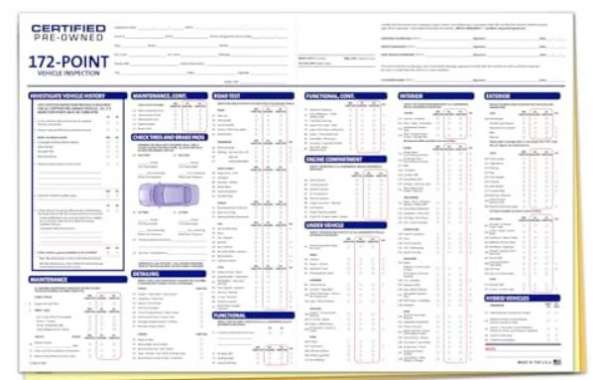What Is a Multipoint Inspection Sheet?
A multipoint inspection sheet is a checklist used during vehicle inspections. It helps mechanics examine different car parts to ensure they are working well. The sheet covers various areas of the vehicle, such as the engine, brakes, tires, and lights. By following this checklist, mechanics can quickly identify any issues that need attention.
Why Use a Multipoint Inspection Sheet?
- Thorough Checks: Using a multipoint inspection sheet ensures that no part of your vehicle is overlooked. Mechanics can systematically check everything, which helps catch problems before they become serious.
- Peace of Mind: Knowing that your car has been inspected thoroughly can give you peace of mind. You can drive confidently, knowing your vehicle is in good shape.
- Safety: Regular inspections are crucial for your safety. If parts like brakes or lights malfunction, accidents can occur. A multipoint inspection sheet helps ensure that these critical components are functioning correctly.
- Cost-Effective: Catching issues early can save you money in the long run. If a small problem is identified during a routine inspection, it can often be fixed before it turns into a costly repair.
What Does a Multipoint Inspection Sheet Include?
A typical multipoint inspection sheet includes several key areas to check. Here's a breakdown of what you might find on a multi point inspection checklist:
- Engine Checks
- Oil Level: Is the oil level sufficient?
- Coolant Level: Is there enough coolant to prevent overheating?
- Belts and Hoses: Are there any cracks or wear signs?
- Brakes
- Brake Pads: Are the brake pads worn down?
- Brake Fluid: Is the brake fluid at the correct level?
- Brake Lights: Are the brake lights functioning correctly?
- Tires
- Tread Depth: Is there enough tread for safe driving?
- Pressure: Are the tire pressures at the recommended levels?
- Alignment: Is the vehicle appropriately aligned?
- Lights
- Headlights: Are the headlights bright enough?
- Turn Signals: Do the turn signals work?
- Brake Lights: Are the brake lights working when the pedal is pressed?
- Battery
- Connections: Are the battery connections tight and clean?
- Voltage: Is the battery holding a proper charge?
- Exterior Checks
- Wipers: Are the windshield wipers functioning correctly?
- Fluid Levels: Is there enough washer fluid?
- Body Condition: Are there any visible signs of damage or rust?
- Interior Checks
- Seat Belts: Are the seat belts working correctly?
- Dashboard Lights: Do all dashboard lights function?
- Air Conditioning: Is the air conditioning system working?
How Often Should You Use a Multipoint Inspection Sheet?
Regularly using a multipoint inspection sheet can help keep your vehicle in top condition. Many experts recommend having your car inspected at least twice a year. This way, you can catch any issues early and keep your vehicle safe and reliable. Consider more frequent inspections if you frequently drive long distances or in harsh conditions.
The Benefits of a Multipoint Inspection
Increased Longevity of Your Vehicle
Regular inspections can help extend the life of your car. When parts are checked and maintained regularly, they are less likely to wear out quickly. This can save you money in the long run by avoiding major repairs.
Enhanced Performance
A well-maintained vehicle runs better. Regular checks can help ensure your engine is running smoothly, your brakes are working efficiently, and your tires are in good condition. This can enhance your car's overall performance and fuel efficiency.
Better Resale Value
If you plan to sell your car, a documented history of regular inspections can increase its resale value. Buyers are often willing to pay more for a vehicle that has been well cared for and maintained.
How to Conduct a Multipoint Inspection
While it's best to leave inspections to professionals, you can perform a simple version of a multipoint inspection yourself. Here's how:
- Get a Checklist: Use a multipoint inspection sheet or checklist that covers the critical areas mentioned above.
- Check the Fluids: Start with the engine oil, coolant, and brake fluid. Make sure they are at the correct levels.
- Inspect the Tires: Check the tire pressure and tread depth. Look for any visible damage.
- Test the Lights: Turn on your headlights, brake lights, and turn signals to ensure they function.
- Listen for Noises: Listen for any unusual noises that could indicate problems while driving.
- Schedule a Professional Inspection: If you notice anything concerning, take your vehicle to a professional for a full inspection.
Conclusion
In conclusion, a multipoint inspection sheet is crucial for maintaining your vehicle. It helps ensure that all parts function correctly, providing safety and peace of mind. Regular inspections can save money, enhance your car's performance, and extend its lifespan. Whether you're a seasoned car owner or a new driver, understanding the importance of a multi-point inspection checklist can help you take better care of your vehicle. So, keep track of your car's health with regular inspections and stay safe on the road!




